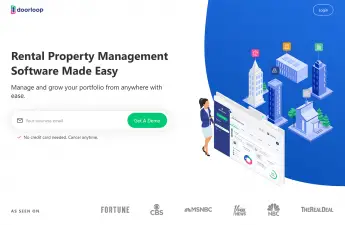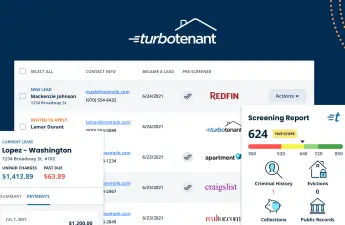Renowned for its user-friendly interface and vast database, Zillow has become synonymous with effortless property hunting and listing. As a leading platform in the industry, Zillow offers a range of features tailored to both renters and landlords alike. Although, it’s important to keep in mind that Zillow is still missing many features that other property management software offers.
In our recent rental property journey, Zillow stood out as a star performer, especially for single-family homes. Over the past 8 to 10 months, when vacancies were a challenge, Zillow consistently brought in a significant number of potential tenants. What we found interesting is that people seem to trust Zillow more for finding single-family houses. Maybe it’s because they’re used to using Zillow for buying and selling homes. This familiarity seemed to translate into more people checking out our rental listings on Zillow compared to other platforms. It just goes to show how Zillow’s focus on real estate helps landlords like us find tenants more easily, especially for certain types of properties.
In this article, we discuss Zillow’s tools and services and compare them with other prominent rental platforms such as Realtor.com, Apartments.com, and Rent.com.
Comparison of Key Features
Let’s take a look at the unique offerings and advantages that set Zillow apart in this competitive landscape.
1. Listing Exposure
With millions of monthly visitors flocking to the site, Zillow offers high visibility for rental listings, ensuring maximum exposure for landlords. Comparatively, platforms like Realtor.com, Apartments.com, and Rent.com may boast substantial traffic, but Zillow’s sheer magnitude in terms of market penetration often outshines them.
Moreover, Zillow’s cross-posting capabilities and seamless integration with other sites amplify its effectiveness in reaching potential tenants. Landlords can effortlessly sync their listings across multiple platforms, extending their reach and maximizing the chances of finding suitable renters. This integration not only simplifies the listing process but also ensures consistency across various platforms, enhancing the overall efficiency of rental property management.
2. Ease of Use
In terms of user-friendliness, Zillow offers an intuitive interface that simplifies the rental process for both landlords and renters. Zillow’s interface is praised for its straightforward navigation and comprehensive features, making it a preferred choice among users.
We find Zillow’s dashboard easy to navigate, with intuitive tools for managing listings, responding to inquiries, and tracking metrics. The platform’s user-friendly design streamlines the rental process, allowing landlords to list properties swiftly and efficiently. Renters also benefit from Zillow’s user-centric approach, with features like customizable search filters and interactive maps making it easy to find their ideal rental.
User reviews echo these sentiments, with many lauding Zillow’s simplicity and convenience. Landlords appreciate the platform’s seamless integration with property management tools, while renters commend its user-friendly interface and detailed listings.

3. Tenant Screening Tools
Zillow offers a comprehensive suite of features designed to empower landlords with the information they need to make informed decisions. From background checks to credit reports and eviction history, Zillow’s screening tools provide a holistic view of potential tenants, enabling landlords to mitigate risk and find reliable renters.
Comparatively, other rental platforms may offer similar screening features, but Zillow stands out for its comprehensiveness and ease of use. Landlords can access detailed reports quickly and conveniently, thanks to Zillow’s seamless integration of screening tools into the rental process. Additionally, the platform’s transparent pricing model ensures landlords know exactly what to expect in terms of costs, without any hidden fees or surprises.
Feedback from users indicates high satisfaction with Zillow’s tenant screening tools, citing the depth of information provided and the platform’s user-friendly interface. Landlords appreciate the ability to access vital screening data in one centralized location, streamlining the tenant selection process and saving valuable time.
4. Pricing and Fees
Understanding the costs associated with listing rentals on Zillow compared to other platforms is essential for landlords seeking to maximize their return on investment.
How much does Zillow charge to list a rental? Zillow offers a range of pricing options tailored to suit different needs and budgets. You can choose between a free basic listing option or opt for paid features such as increased listing exposure or enhanced marketing tools for a fee. Zillow charges additional fees for certain services, such as tenant screening reports or premium placement on search results pages.
In contrast, other rental platforms like Realtor.com, Apartments.com, and Rent.com may have their own pricing structures, including subscription fees, pay-per-listing rates, or additional service fees.
When evaluating the return on investment of each platform, you should consider factors such as the cost of listing fees, the level of exposure provided, and the features included with each pricing tier. While Zillow may have higher upfront costs for certain premium features, its extensive reach and user base often result in a higher return on investment in terms of attracting qualified leads and securing tenants.
Ultimately, you should weigh the costs and benefits of each platform to determine the most cost-effective option for their rental property listings. By carefully considering pricing and fees alongside features and exposure, you can make informed decisions to maximize their rental property investment.
5. Integration and Additional Tools
The availability of additional tools beyond listing capabilities can significantly impact landlords’ efficiency and convenience. Zillow stands out not only for its robust listing features but also for its integration of supplementary tools aimed at simplifying various aspects of rental management.
Zillow offers a range of additional tools, including rental payment processing, lease signing capabilities, and maintenance request tracking. These features streamline crucial aspects of rental property management, allowing landlords to collect rent, execute leases, and address maintenance issues seamlessly within the platform.
With Zillow, landlords can centralize their rental management tasks, eliminating the need to juggle multiple services or platforms. This integration fosters efficiency and organization, ultimately saving landlords time and effort.
However, some landlords may prefer specialized services for certain tasks, such as dedicated property management software for more extensive portfolios or niche platforms for specific rental markets. While specialized services may offer advanced features tailored to specific needs, they often require additional subscriptions or integrations, potentially complicating the rental management process.
Landlord Gurus Takeaway
Zillow’s strengths lie in its extensive reach and user base, intuitive interface, and comprehensive suite of tools, including robust listing exposure, tenant screening capabilities, and additional management tools like rental payment processing and lease signing. While these features make Zillow an attractive option, it also does not offer features that other property management software offer.
Additionally, Zillow’s pricing structure, while flexible, may present a barrier for some landlords, particularly those with tighter budgets or smaller property portfolios. While Zillow excels in certain areas like single-family homes, its effectiveness may vary depending on property type and market dynamics.
When choosing the right platform, landlords and property managers should consider their specific needs and priorities. Factors such as budget, property type, desired level of involvement in the rental process, and market preferences should all be taken into account.
Ultimately, the key is to assess the strengths and weaknesses of each platform in relation to your unique requirements and preferences, ensuring that the chosen platform aligns closely with your goals and objectives in rental property management. By making an informed decision based on these factors, landlords can maximize their success and efficiency in the competitive rental market landscape.
No matter what platform you choose, check out our tips on how to list a rental property.

Disclosure: Some of the links in this post are affiliate links and Landlord Gurus may earn a commission. Our mission remains to provide valuable resources and information that helps landlords manage their rental properties efficiently and profitably. We link to these companies and their products because of their quality, not because of the commission.




